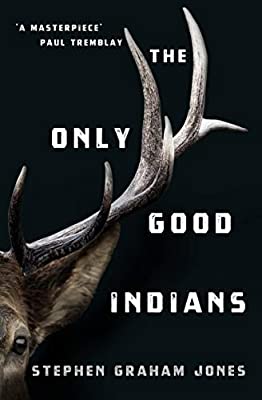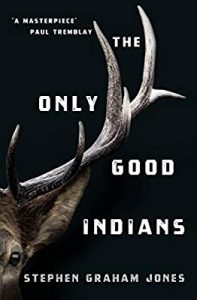
The Indigenous Literature Reading Group met on October 2nd 2020 to discuss Jones’s 2020 novel (https://titanbooks.com/70389-the-only-good-indians/)
Shelley Saggar writes:

The Only Good Indians, Stephen Graham Jones
‘Let there be bad Indians’ concludes Stephen Graham Jones’ literary manifesto, ‘Letter to a Just-Starting-Out Indian Writer’. Imploring fellow authors to refuse the essentialism of the Native American trauma narrative, Jones calls instead for characters that are defined not by a need to prove how “good” or “authentic” they are, but by their sincerity. The Only Good Indians, Jones’ most recent novel, toys with the long-standing cultural temptation to cast Native Americans as “good” and “bad” by narrating the experiences of four central characters who break cultural hunting protocols to commit an act of violent excess upon an animal; the experience of which returns to haunt them a decade later.
Gabe, Cass, Ricky and Lewis are cast as irresponsible youths fuelled into an act of cruelty by the pressure of hyper-masculinity. Lewis’ initial killing of a mother elk and her calf are the catalyst for a disturbing pattern of gendered violence that litters the novel. The string of killings gestures to the epidemic of Missing and Murdered Indigenous Women, Girls and Two-Spirit Peoples (MMIWG2S) across what is currently known as North America. This quiet invocation of socio-political issues is typical of The Only Good Indians, which continually invites readers to connect subtle details of character, plot and setting to wider critical discussions in Native America. However, Jones insists on being read first as an artist, who ‘happens to be American Indian’ second.
Continually playing with critical expectations, the novel refuses to be contained by generic conventions. Even the title sets The Only Good Indians up as not “just” another horror fiction. Referencing Phillip Sheridan’s infamous statement: ‘the only good Indian is a dead Indian’, the title positions the text within the context of genocidal settler-violence and asks the reader to be aware of the ominous weight of history that underscores the narrative. However, Jones refuses the trope of traumatised victimhood to explain away the characters’ transgression. Instead, his skill is to nuance the binary of “good” and “bad” to create a depth of character that breaks free of the representative responsibilities so often imposed by both critical and commercial markets.
For example, Denorah, Gabe’s teenage daughter, is the lone survivor at the end of the novel; tempting the reader to perceive her as being spared because of her realisation of a kinship relationship with the elk – a striking contrast to her father’s revelry in irresponsibility. However, any reading of Denorah as therefore more connected to Nature (and therefore more stereotypically “Indigenous”) is misplaced. As she thinks to herself: ‘ trees are only good to make basketball courts from’ she refuses the paradigm of elvin liminality that Jones identifies in his manifesto and instead steps into an experience of Indigenous womxnhood that is at once all her own. The close of the book offers its most overtly political maneuver. As Denorah’s story is transformed into the stuff of legend, (both on and off the basketball court), the echoes of her tale continue to shape Blackfeet culture far into a speculative future that insists on the vibrancy of Indigenous life against the violence of attempts at erasure.
Bio:
Shelley Angelie Saggar is a CHASE PhD student in the School of English at Kent and a member of the Centre for Indigenous and Settler Colonial Studies. Her PhD looks at contestations and reclamations of museum space in Native North American and Aotearoan literatures.
Our next meeting takes place on November 13th. We will be discussing Tommy Orange’s There There.